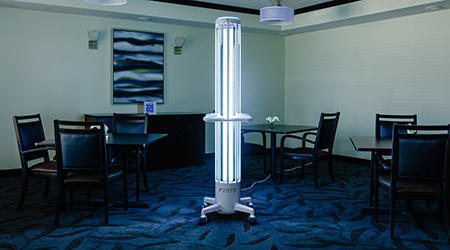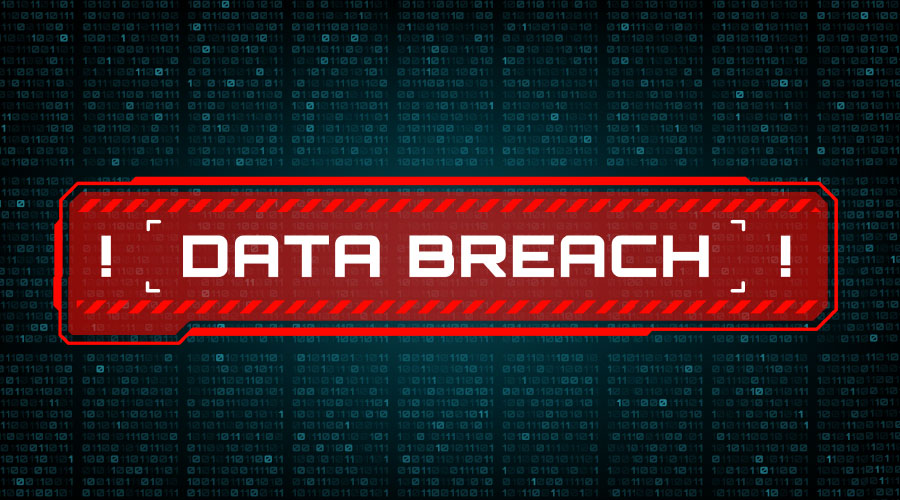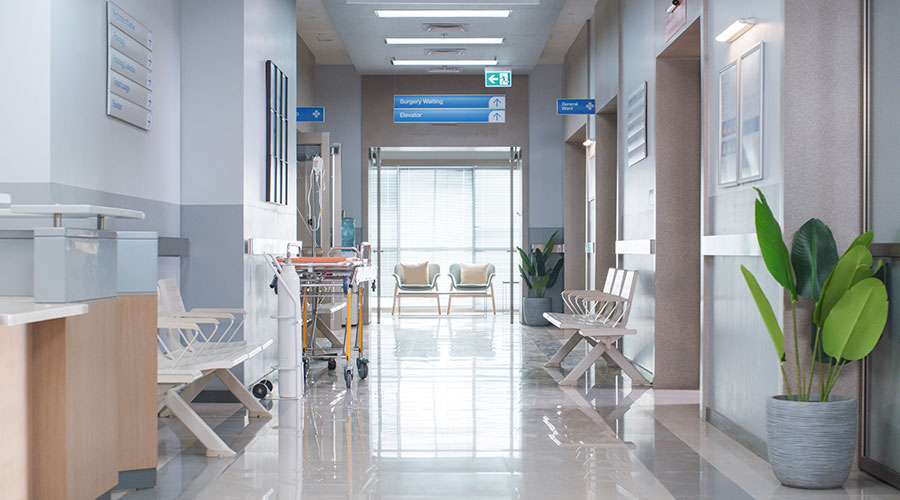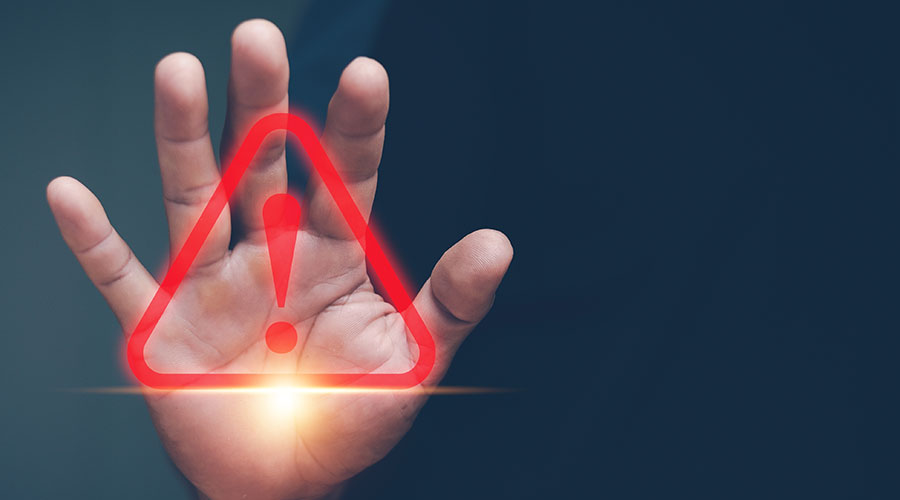Trilogy Health Services prides itself on treating employees and residents like family. So in the early days of the pandemic, the senior care provider with headquarters in Louisville, Kentucky, began to reevaluate its safety policies and procedures. The company needed to address the immediate threat of COVID-19, but more importantly, it wanted to future-proof the safety and wellbeing of its staff and elderly residents.
“The pandemic gave us the opportunity to look at how we could elevate our environmental care,” says Parker Lacy, vice president of facility management. “We knew we needed to change our operations, not just to address COVID-19 today but to develop a viable, long-term solution to keep people safe inside our buildings.”
After exploring a number of technologies, the company chose R-Zero’s Arc disinfection system for surfaces and air. The device uses UV-C light — ultraviolet light in the range of 200 to 300 nm—to rupture the cell walls of pathogens and prevent them from replicating.
Trilogy Health Services chose the UV-C system for its usefulness, simplicity and reporting capabilities, as well as its clinicaleffectiveness at the campus level, Lacy says. In October 2020, the company purchased 10 systems and piloted them at 10 of its 100-plus senior living campuses across the Midwest.
Rapid rollouts
Trilogy’s senior living communities are designed to offer a continuum of care for residents and their aging process. The campuses offer multiple service options, including assisted and independent living, skilled nursing, and memory care. Each location houses between 70 and 100 residents and has a footprint of approximately 100,000 square feet. Facilities include resident rooms, common areas, activity rooms, dining rooms and full-service kitchens.
During the initial rollout, Trilogy focused on familiarizing staff with the technology and training them to use the system. After watching an instructional video online, operators received hands-on training from support staff on site. Trilogy also worked closely with the vendor to structure the device’s reporting capabilities for real-time usage and compliance data.
“After about 30 days, we felt confident with the technology, and we made a bold move: We purchased a device for every campus,” says Lacy.
Over the next five months, Trilogy staggered rollouts of UV-C systems to all of its campuses at the rate of four to five units per week. The implementation was completed in March 2021. Based on feedback from staff, operational improvements are ongoing, ensuring that the devices are being used to their full potential.
“It proved easier to implement than originally thought, so we ended up using it in just about every room in the campus — front and back of house,” says Lacy. “It was also a lot easier to operate than we initially thought, so we ended up training all team members on the operation of the unit.”
Additionally, Trilogy ensured that its sales team and other department leaders were well educated about the device and the protection it affords, which proved comforting to potential residents and employees.
Layered protection
Trisha Marvin is the senior director of environmental services for Trilogy’s south region. At her home campus of Gateway Springs in Fairfield Township, Ohio, the UV-C system is used to disinfect high-traffic areas, such as break rooms, activity rooms, conference rooms and public restrooms. It is also used to disinfect resident rooms upon discharge. Marvin estimates that the system is in use for 3.5 hours in common areas and five to 10 hours in resident rooms over the course of a week.
“The training process is really easy, and it doesn’t take long to set up,” says Marvin. “The device is on wheels, and it has crash bars, so it’s easy to maneuver around the building.”
Once the unit is in position, the operator plugs it in, turns it on and selects the appropriate cycle. The device measures the size of the room to determine the cycle length and can disinfect an area of up to 1,000 square feet in seven minutes.
Like Marvin, Jordan Perry, director of environmental services at the Vienna Springs campus, Miami Township, Ohio, also uses the UV-C device to disinfect common areas and resident rooms as needed.
“After the housekeeper cleans and disinfects the resident’s room, we run a five-minute cycle in the bathroom and another five-minute cycle in the bedroom,” she says. “In the public areas, we run the machine for seven minutes.”
Because UV-C light can cause skin and eye irritation, the device is only used when rooms are unoccupied. Typically, the operator runs the device in the bathroom first while cleaning the resident’s room. A pre-cycle countdown allows the operator to leave the room safely before the cycle starts, and the machine shuts down automatically if it detects movement in the room during treatment.
Perry says that UV-C light is not a replacement for regular cleaning and disinfecting practices. Rather, the technology is an adjunct service that provides an extra layer of protection for hard-to-reach areas or surfaces that might have been overlooked during manual cleaning.
“We still disinfect daily using a quaternary disinfectant and microfiber cloths or germicidal wipes for areas that cannot be sprayed, such as clocks and keyboards,” Marvin says. “For high-touch areas, we use backpack sprayers twice a day to spray the disinfectant onto the surface and let it air dry.”
UV-C technology is one of several safety protocols that make up Trilogy’s SHIELD program, a cleanliness initiative to protect residents from infectious diseases.
“We wanted to create a shield of protection for our employees and residents at our campuses and accelerate what we were doing indoors to keep people safe and healthy,” says Lacy.
Additional safety measures include more frequent disinfection of high-touch surfaces, the introduction of personal protection equipment, vaccination policies and air filtration upgrades. In the wake of the pandemic, Trilogy increased its air filtration rating, as well as the frequency of filter changes. The UV-C light also improves indoor air quality by destroying pathogens in the air and on surfaces.
To determine the effectiveness of UV-C technology, Trilogy uses ATP meters to measure the cleanliness of surfaces post-treatment. According to Lacy, the results are impressive.
“Our scores were good before the pandemic, but with the implementation of the UV devices they’re topnotch,” Lacy says. “In fact, they exceeded our expectations and set a new standard for our level of cleanliness.”
Not only is Trilogy able to measure the effectiveness of UV technology, but it is able to determine whether the device is being used appropriately. The system’s IoT platform tracks and delivers usage and compliance data in real time, providing environmental services teams with an auditable trail of disinfection activity.
“Using our data visualization and analytics tool, we can see all the way down to hallways or individual common areas,” says Lacy. “So it gives us a global perspective on where and how the devices are used, which helps build our knowledge base and identify training opportunities. It also gives us the confidence that our campuses are doing the right thing.”
Peace of mind
One important benefit of using UV-C technology is the reassurance it provides to staff and residents. During visits to different campuses, Marvin says people across the board respond positively to the devices.
“When the residents see them moving through the building and know we’re disinfecting, they feel safer and less on guard about COVID-19,” she says. “We use a sticker to seal the door to the room after the process is complete so that people know the room has been completely sanitized.”
Residents sometimes have questions about the technology, at which point staff members take the time to explain what the machine does and why they use it, says Marvin. Some residents request the UV-C light for their rooms if they are going to be out during the day.
“A lot of our elderly people are very concerned about COVID-19,” says Marvin. “At the end of the day, the UV technology makes them feel safe and comfortable.”
Fortunately, COVID-19 cases among residents have declined steadily since the onset of the pandemic — a product of Trilogy’s multifaceted safety protocols.
“We’ve seen a massive reduction in COVID-19 at our campuses,” says Lacy. “In fact, our infection rate is well below 1 percent. We’re at the point where it’s something we don’t have to address on a daily basis as we did a year ago.”
Trilogy Health Services is expanding at a rate of approximately five new campuses a year and plans to continue adding UV-C devices to each new location. The company’s aim is two to three reductions in hospital acquired infections per campus, says Lacy. In meeting this goal, Trilogy stands to make a return on its initial investment in less than one year.
Meanwhile, the senior care provider continues to track and analyze data from the devices and plans to partner with the University of Kentucky in 2022 to substantiate UV-C technology’s role in reducing hospital-acquired infections.
“We’ve had preliminary discussions with some of the professors about working together on a grant study through CDC,” says Lacy. “The clinical data is compelling, and we know that the devices are having an effect in our campuses. By working hand in hand with the University of Kentucky, we can make sure that the data is validated in the right way.”
Kassandra Kania is a freelancer based in Charlotte, North Carolina. She is a frequent writer on cleaning and infection control topics.

 Oracle Health Hit by Data Breach, Patient Data Possibly Compromised
Oracle Health Hit by Data Breach, Patient Data Possibly Compromised Ground Broken on New MD Anderson Sugar Land Facility
Ground Broken on New MD Anderson Sugar Land Facility Florida State University Reveals Plans for Panama City Beach Hospital
Florida State University Reveals Plans for Panama City Beach Hospital The Effect of Over-Cleaning on Human Health
The Effect of Over-Cleaning on Human Health Rumored Terror Threat to Hospitals Prompts FBI Warning
Rumored Terror Threat to Hospitals Prompts FBI Warning